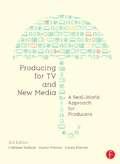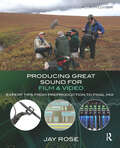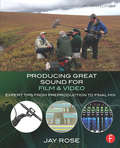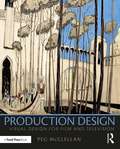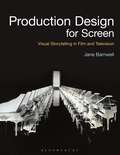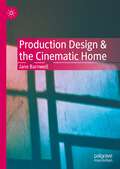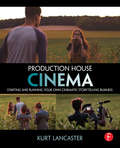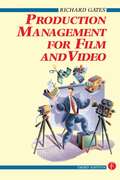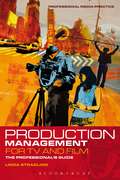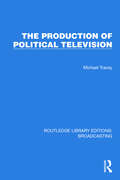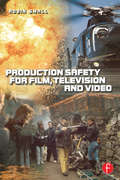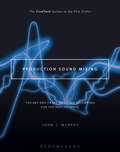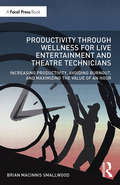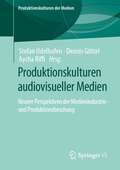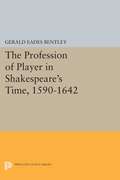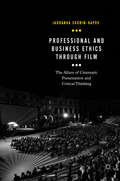- Table View
- List View
Producing for TV and New Media: A Real-World Approach for Producers
by Cathrine Kellison Dustin Morrow Kacey MorrowThis book provides a thorough look at the role of the producer in television and new media. Written for new and aspiring producers, it looks at both the big picture and the essential details of this demanding job. In a series of interviews, seasoned TV and new media producers share their real-world professional practices to provide rich insight into the complex, billion-dollar industries. The third edition features more on the topics of new media and what that encompasses, covering the expansion of the global marketplace of media content. The traditional role of a television producer is transforming into a new media producer, and this book provides a roadmap to the key differences, and similarities, between the two.
Producing Great Sound for Film and Video: Expert Tips from Preproduction to Final Mix
by Jay RoseIn Producing Great Sound for Film and Video, Fourth Edition audio guru Jay Rose revises his popular text for a new generation of filmmakers. You’ll learn practical, time-saving ways to get better recordings, solve problems with existing audio, create compelling tracks, and boost your filmmaking to the next level! Here you’ll find real-world advice and practical guidelines for every aspect of your soundtrack: planning and budgeting, field and studio recording, editing, sound effects and music, audio repair, processing, and mixing. Rose’s combination of solid technical information and a clear, step-by-step approach has made this the go-to book for producers and film students for over a decade. New in this edition: Insights and from-the-trenches tips from top professionals Instructions for getting the best results from new DSLRs and digital recorders An all-new companion website www.GreatSound.info with downloadable diagnostics, examples, and exercises for you to try What you need to know about new regulations for wireless mics and broadcast loudness An expanded "How Do I Fix This?" section to help you solve problems quickly Whether you’re an aspiring filmmaker who wants better tracks, or an experienced professional looking for a reference, Producing Great Sound for Film and Video, Fourth Edition has the information you need. Please visit the book's companion website for more information and companion files: http://www.GreatSound.info
Producing Great Sound for Film and Video: Expert Tips from Preproduction to Final Mix
by Jay RoseIn Producing Great Sound for Film and Video, Fourth Edition audio guru Jay Rose revises his popular text for a new generation of filmmakers. You’ll learn practical, time-saving ways to get better recordings, solve problems with existing audio, create compelling tracks, and boost your filmmaking to the next level! Here you’ll find real-world advice and practical guidelines for every aspect of your soundtrack: planning and budgeting, field and studio recording, editing, sound effects and music, audio repair, processing, and mixing. Rose’s combination of solid technical information and a clear, step-by-step approach has made this the go-to book for producers and film students for over a decade. New in this edition: Insights and from-the-trenches tips from top professionals Instructions for getting the best results from new DSLRs and digital recorders An all-new companion website www.GreatSound.info with downloadable diagnostics, examples, and exercises for you to try What you need to know about new regulations for wireless mics and broadcast loudness An expanded "How Do I Fix This?" section to help you solve problems quickly Whether you’re an aspiring filmmaker who wants better tracks, or an experienced professional looking for a reference, Producing Great Sound for Film and Video, Fourth Edition has the information you need. Please visit the book's companion website for more information and companion files: http://www.GreatSound.info
Production Design: Visual Design for Film and Television
by Peg McClellanProduction Design: Visual Design for Film and Television is a hands-on guide to the craft of Production Design and Art Direction. Author Peg McClellan gives an insider’s view of the experiences and challenges of working as a Production Designer in film and television. The book covers three major areas, starting with an overview and the basics of job responsibilities, the artistic approach and the background which every Production Designer needs to be familiar with, and progressing to the mechanics of the role with a day-to-day breakdown of the job itself. McClellan takes you through script analysis, team collaborations, the hierarchy of a production, hiring a team, the business elements, locations, studio facilities, handling change, and everything in between. With case studies, insights from successful Production Designers, and inspiration in the form of over 200 colour photos and illustrations from storyboards to sets, this is the ideal book for students seeking a career in production design, and professionals looking to further their design knowledge.
Production Design: Visual Design for Film and Television
by Peg McClellanProduction Design: Visual Design for Film and Television is a hands-on guide to the craft of Production Design and Art Direction. Author Peg McClellan gives an insider’s view of the experiences and challenges of working as a Production Designer in film and television. The book covers three major areas, starting with an overview and the basics of job responsibilities, the artistic approach and the background which every Production Designer needs to be familiar with, and progressing to the mechanics of the role with a day-to-day breakdown of the job itself. McClellan takes you through script analysis, team collaborations, the hierarchy of a production, hiring a team, the business elements, locations, studio facilities, handling change, and everything in between. With case studies, insights from successful Production Designers, and inspiration in the form of over 200 colour photos and illustrations from storyboards to sets, this is the ideal book for students seeking a career in production design, and professionals looking to further their design knowledge.
Production Design for Screen: Visual Storytelling in Film and Television (Required Reading Range)
by Jane BarnwellPacked with colour film stills, exclusive pre-production artwork and behind-the-scenes production images, this landmark book celebrates the production designer's contribution to visual storytelling on screen. It illuminates the visual concepts behind familiar screen spaces and unpicks how and why they are so effective in conveying character and story.Seven case studies, developed from exclusive interviews with world-renowned designers, reveal the concepts behind some of the most engaging imagery on screen and establish a dialogue around the shared language of visual storytelling. Jane Barnwell offers a new methodology for evaluating the designer's work on screen through five categories of analysis: space, interiors and exteriors, light, colour and set decorating. All of which combine to create the visual concept evident in the final screen image and together provide a model for the analysis of production design.Practical exercises and examples of real world projects walk you through the design process from breaking down the script and developing initial ideas to identifying a coherent conceptual vision. If you are a filmmaker, Production Design for Screen will inspire and guide you in your own work.
Production Design & the Cinematic Home
by Jane BarnwellThis book uses in-depth case studies to explore the significance of the design of the home on screen. The chapters draw widely upon the production designer’s professional perspective and particular creative point of view. The case studies employ a methodology Barnwell has pioneered for the analysis of production design called Visual Concept Analysis, which can be used as a key to decode the design of any given film. Through the nurturing warmth of the Browns’ home in Paddington, the ambiguous boundaries of secret service agent homes in Tinker Tailor Soldier Spy and the ‘singleton’ space occupied by Bridget Jones, Barnwell demonstrates that the domestic interior consistently plays a key role. Whether used as a transition space, an ideal, a catalyst for change or a place to return to, these case studies examine the pivotal nature of the home in storytelling and the production designers’ significance in its creation. The book benefits from interviews with production designers and artwork that provides insight on the creative process.
Production House Cinema: Starting and Running Your Own Cinematic Storytelling Business
by Kurt LancasterIn Production House Cinema: Starting and Running Your Own Cinematic Storytelling Business, renowned video storyteller Kurt Lancaster offers both students and professionals a practical guide to starting their own video production company and creating cinematic, client-based video content. Utilizing practical know-how along with in-depth analysis and interviews with successful independent production houses like Stillmotion and Zandrak, Lancaster follows the logistics and inspiration of creating production house cinema from the initial client pitch all the way through financing and distribution. The book includes: An examination of the cinematic and narrative style and how to create it; A discussion of the legal procedures and documents necessary for starting and operating a production house; Advice on crafting a portfolio, reel, and website that both demonstrates your unique style and vision and attracts clients; A guide to the financial business of running an independent production house, including invoicing, accounting, and taxes—and how much you should charge clients; Tips for how to better communicate with clients, and how to develop and shape a client’s story; A breakdown of how to select the right gear and equipment for a shoot, on budget; Cinematic case studies that offer detailed coverage of several short films made for clients.
Production House Cinema: Starting and Running Your Own Cinematic Storytelling Business
by Kurt LancasterIn Production House Cinema: Starting and Running Your Own Cinematic Storytelling Business, renowned video storyteller Kurt Lancaster offers both students and professionals a practical guide to starting their own video production company and creating cinematic, client-based video content. Utilizing practical know-how along with in-depth analysis and interviews with successful independent production houses like Stillmotion and Zandrak, Lancaster follows the logistics and inspiration of creating production house cinema from the initial client pitch all the way through financing and distribution. The book includes: An examination of the cinematic and narrative style and how to create it; A discussion of the legal procedures and documents necessary for starting and operating a production house; Advice on crafting a portfolio, reel, and website that both demonstrates your unique style and vision and attracts clients; A guide to the financial business of running an independent production house, including invoicing, accounting, and taxes—and how much you should charge clients; Tips for how to better communicate with clients, and how to develop and shape a client’s story; A breakdown of how to select the right gear and equipment for a shoot, on budget; Cinematic case studies that offer detailed coverage of several short films made for clients.
Production Management for Film and Video
by Richard GatesPacked with step by step information, hints and tips, this book provides all the basic information needed to production manage a film or video from beginning to end - from idea to delivery. Production Management for Film and Video gives all the basic information needed to production manage a film or video from beginning to end - from idea to delivery.Aspiring young film producers, programme makers and students of film or video production will find this an essential source of information, as indeed will anybody wishing to improve their knowledge and skills in the field. One is guided from the script or proposal, right through the various stages of production management to include:· script breakdown· crossplotting· scheduling· budgeting· preparation· the shoot· editing and post-production· deliveryNow in its third edition, Production Management for Film and Video has been further revised to include: · information on health and safety requirements· the need to be aware of computer generated imagery · the effect this kind of programme making has on schedules and budgets. Different kinds of management for different productions are also covered - from features through to documentaries - and advice is offered on how to run a production more effectively. Examples, taken from actual productions, demonstrate the kind of documentation needed to develop, run and control a production. Emphasis is placed on the basic principles of good management that apply to all the different kinds of film that can be produced.Richard Gates is a freelance producer/production manager and has been involved in over 40 productions of different kinds. He also lectures extensively on production and production management techniques.
Production Management for Film and Video
by Richard GatesPacked with step by step information, hints and tips, this book provides all the basic information needed to production manage a film or video from beginning to end - from idea to delivery. Production Management for Film and Video gives all the basic information needed to production manage a film or video from beginning to end - from idea to delivery.Aspiring young film producers, programme makers and students of film or video production will find this an essential source of information, as indeed will anybody wishing to improve their knowledge and skills in the field. One is guided from the script or proposal, right through the various stages of production management to include:· script breakdown· crossplotting· scheduling· budgeting· preparation· the shoot· editing and post-production· deliveryNow in its third edition, Production Management for Film and Video has been further revised to include: · information on health and safety requirements· the need to be aware of computer generated imagery · the effect this kind of programme making has on schedules and budgets. Different kinds of management for different productions are also covered - from features through to documentaries - and advice is offered on how to run a production more effectively. Examples, taken from actual productions, demonstrate the kind of documentation needed to develop, run and control a production. Emphasis is placed on the basic principles of good management that apply to all the different kinds of film that can be produced.Richard Gates is a freelance producer/production manager and has been involved in over 40 productions of different kinds. He also lectures extensively on production and production management techniques.
Production Management for TV and Film: The professional's guide (Professional Media Practice)
by Linda Stradling"What Linda Stradling doesn't know about production management isn't worth knowing" The Documentary Filmmakers GroupPlaying a key role in helping producers to interpret and realise the directors' vision, production managers are responsible for all organisational aspects of TV and film production - from start to finish. Now this essential handbook tells you how it's done. Written by highly experienced production manager and specialist tutor, Linda Stradling, this is a complete guide to the profession. It includes details on self-organisation and the best systems to use, budgets, schedules and cost control, hiring and firing, contracts, insurance, setting up a shoot, dealing with contributors, acquiring copyright, people skills and ethics. So whether you're just starting out or want to improve your knowledge and skills, this is the book for you.
Production Management for TV and Film: The professional's guide (Professional Media Practice)
by Linda Stradling"What Linda Stradling doesn't know about production management isn't worth knowing" The Documentary Filmmakers GroupProduction Managers are responsible for all the organisational aspects of a TV or film production such as scheduling and budgeting and assisting producers to interpret and realise the directors' vision. Linda Stradling is a highly experienced production manager and trainer. Her book is based on her training handouts and notes and offers a complete `manual' to the role including: self organisation and systems to use, budgets, schedules and cost control, cash flow, hiring and firing, contracts, insurance, health and safety, setting up an efficient and cost-effective shoot, dealing with contributors, acquiring copyright, sourcing CGI, editors, music cue sheets, deliverables, people skills and ethics. A chapter contribution is included from leading drama production manager Julie Clark (currently line producer on Glorious 39, Stephen Poliakoff's new film). Written by an industry insider, this is an exhaustive manual to every aspect of the job, with reference material and real-life examples. Essential paperwork and sample budgets can also be found on our website. A complete on-the-job reference tool.
The Production of Political Television (Routledge Library Editions: Broadcasting #29)
by Michael TraceyThe Production of Political Television (1977) is a study of the organization and methods of production of political television that covers not only news broadcasts and current affairs programmes but all programmes involved with the policy making process in Britain. It examines the procedures by which producers put their programmes together, and analyses the impact of external institutions on the programme-making process.
The Production of Political Television (Routledge Library Editions: Broadcasting #29)
by Michael TraceyThe Production of Political Television (1977) is a study of the organization and methods of production of political television that covers not only news broadcasts and current affairs programmes but all programmes involved with the policy making process in Britain. It examines the procedures by which producers put their programmes together, and analyses the impact of external institutions on the programme-making process.
Production Safety for Film, Television and Video
by Robin SmallCovering all aspects of production safety, this is an invaluable reference guide for the independent programme maker, freelancer, manager, producer, tutor and student filmmaker. Robin Small identifies all the major risks and gives advice on how to control and/or eliminate them. Each hazard section includes useful references to the relevant legislation, documents and licences, as well as addresses of organisations for essential advice and recommended further reading. An appendix lists samples of vital certificates, with visual references provided on www.focalpress.com. Important information about hazard identification, risk assessment and safety policy is provided in the chapters covering legislation, health and safety management, personal protective equipment and insurance. Particular hazards are then split into individual sections for ease of reference. These hazards include:AsbestosCranesExplosives and pyrotechnicsFood and cateringManual handing and liftingVisual display screensWorking at heightsThe appendices provide comprehensive contact information for UK and European Heath and Safety sources. They also include sample forms to draw up your own safety system.Robin Small is Senior Lecturer in Television, Media Department at the University of Huddersfield.
Production Safety for Film, Television and Video
by Robin SmallCovering all aspects of production safety, this is an invaluable reference guide for the independent programme maker, freelancer, manager, producer, tutor and student filmmaker. Robin Small identifies all the major risks and gives advice on how to control and/or eliminate them. Each hazard section includes useful references to the relevant legislation, documents and licences, as well as addresses of organisations for essential advice and recommended further reading. An appendix lists samples of vital certificates, with visual references provided on www.focalpress.com. Important information about hazard identification, risk assessment and safety policy is provided in the chapters covering legislation, health and safety management, personal protective equipment and insurance. Particular hazards are then split into individual sections for ease of reference. These hazards include:AsbestosCranesExplosives and pyrotechnicsFood and cateringManual handing and liftingVisual display screensWorking at heightsThe appendices provide comprehensive contact information for UK and European Heath and Safety sources. They also include sample forms to draw up your own safety system.Robin Small is Senior Lecturer in Television, Media Department at the University of Huddersfield.
Production Sound Mixing: The Art and Craft of Sound Recording for the Moving Image (The CineTech Guides to the Film Crafts)
by John J. MurphyThe latest hot camera is pretty irrelevant if one can't understand what's happening on screen. The key to any narrative is in the dialogue and voice over, but if this is unintelligible or difficult to hear, viewers will soon lose interest. With real world applications and a narrative to keep the reader's interest, Production Sound Mixing is the indispensable guide for film and video audio recording. Written by veteran sound mixer John J. Murphy, the book offers a step by step collaborative journey through the basic physics of sound, concluding with a practical guide of the latest techniques and equipment available to all who are interested in the best audio for their projects. Structured to mimic a 14-week semester, each chapter begins with an audio problem to be solved and ends with a solution drawn from information gleaned from past chapters. Suggested movie scenes that demonstrate the relevant audio techniques will also be included. Equally applicable to studio and location recording, the book is oriented toward commonly accessible environments such as conference rooms, hallways, beaches, car interiors, bathrooms, and so on. The intent is to allow the student to make the best of a location no matter how challenging it might be. Most importantly, this book will make one aware of the potential of sound on screen, for it is truly 50% of the viewing experience.
Production Sound Mixing: The Art and Craft of Sound Recording for the Moving Image (The CineTech Guides to the Film Crafts)
by John J. MurphyThe latest hot camera is pretty irrelevant if one can't understand what's happening on screen. The key to any narrative is in the dialogue and voice over, but if this is unintelligible or difficult to hear, viewers will soon lose interest. With real world applications and a narrative to keep the reader's interest, Production Sound Mixing is the indispensable guide for film and video audio recording. Written by veteran sound mixer John J. Murphy, the book offers a step by step collaborative journey through the basic physics of sound, concluding with a practical guide of the latest techniques and equipment available to all who are interested in the best audio for their projects. Structured to mimic a 14-week semester, each chapter begins with an audio problem to be solved and ends with a solution drawn from information gleaned from past chapters. Suggested movie scenes that demonstrate the relevant audio techniques will also be included. Equally applicable to studio and location recording, the book is oriented toward commonly accessible environments such as conference rooms, hallways, beaches, car interiors, bathrooms, and so on. The intent is to allow the student to make the best of a location no matter how challenging it might be. Most importantly, this book will make one aware of the potential of sound on screen, for it is truly 50% of the viewing experience.
Productivity Through Wellness for Live Entertainment and Theatre Technicians: Increasing Productivity, Avoiding Burnout, and Maximizing the Value of An Hour
by Brian MacInnis SmallwoodProductivity Through Wellness for Live Entertainment and Theatre Technicians provides the tools for individuals and organizations to achieve a healthy work–life balance and increase productivity in the production process of live entertainment. Through examination of the limits of the human body, the fundamentals of motivation, and best practices of project management, the reader will develop operational mindfulness and look at new ways to achieve work–life balance. The book explores case studies that show how organizations are promoting work–life balance and reaping the benefits of increased productivity, makes recommendations to reduce burnout and increase productivity among technicians, and discusses how to deal with the various phases of production. An excellent resource for live entertainment technicians, production managers, technical directors, arts managers, managers in live entertainment, and students in Technical Direction and Production Management courses, Productivity Through Wellness for Live Entertainment and Theatre Technicians offers practical solutions to improve the quality of life of employees, reduce the burnout and injuries of overwork, and maximize the value of an hour.
Productivity Through Wellness for Live Entertainment and Theatre Technicians: Increasing Productivity, Avoiding Burnout, and Maximizing the Value of An Hour
by Brian MacInnis SmallwoodProductivity Through Wellness for Live Entertainment and Theatre Technicians provides the tools for individuals and organizations to achieve a healthy work–life balance and increase productivity in the production process of live entertainment. Through examination of the limits of the human body, the fundamentals of motivation, and best practices of project management, the reader will develop operational mindfulness and look at new ways to achieve work–life balance. The book explores case studies that show how organizations are promoting work–life balance and reaping the benefits of increased productivity, makes recommendations to reduce burnout and increase productivity among technicians, and discusses how to deal with the various phases of production. An excellent resource for live entertainment technicians, production managers, technical directors, arts managers, managers in live entertainment, and students in Technical Direction and Production Management courses, Productivity Through Wellness for Live Entertainment and Theatre Technicians offers practical solutions to improve the quality of life of employees, reduce the burnout and injuries of overwork, and maximize the value of an hour.
Produktionskulturen audiovisueller Medien: Neuere Perspektiven der Medienindustrie- und Produktionsforschung (Produktionskulturen der Medien)
by Stefan Udelhofen Dennis Göttel Aycha RiffiAls eine der wenigen, deutschsprachigen Überblicksdarstellungen zum interdisziplinären Feld der Production Studies bzw. der Cultural Studies of Media Industries, versammelt der Band aktuelle Beiträge der sozial- und kulturwissenschaftlichen Erforschung von audiovisuellen Medienindustrien in Geschichte und Gegenwart. Neben der Präsentation neuer Erkenntnisse liegt der Schwerpunkt der Beiträge insbesondere auf der theoretischen, methodischen und forschungspraktischen Reflexion, um eine weitergehende Verankerung dieses Forschungsfeldes im deutschsprachigen Raum voranzutreiben.
The Profession of Player in Shakespeare's Time, 1590-1642
by Gerald Eades BentleyThis book is a comprehensive study of the customary practices of English players of the period--how they lived and worked and were paid, organized, and cast for parts in the phenomenally popular theaters of England. Gerald Bentley discusses sharers, hired men, boy apprentices, musicians, touring groups, and managers, showing that players in general led difficult but seriously professional lives.Originally published in 1984.The Princeton Legacy Library uses the latest print-on-demand technology to again make available previously out-of-print books from the distinguished backlist of Princeton University Press. These editions preserve the original texts of these important books while presenting them in durable paperback and hardcover editions. The goal of the Princeton Legacy Library is to vastly increase access to the rich scholarly heritage found in the thousands of books published by Princeton University Press since its founding in 1905.
Professional and Business Ethics Through Film: The Allure of Cinematic Presentation and Critical Thinking (Palgrave Studies In Business, Arts And Humanities Ser.)
by Jadranka Skorin-KapovThis book considers ethical issues arising in professional and business settings and the role of individuals making decisions and coping with moral dilemmas. Readers can benefit from engagement in filmic narratives, as a simulated environment for developing a stance towards ethical challenges. The book starts by elaborating on critical thinking and on normative ethical theories, subsequently presenting the structure and cinematic elements of narrative film. These two avenues are tools for evaluating films and for discussions on various ethical problems in contemporary business, including: the corporate and banking financial machinations (greed, fraud, social responsibility); workplace ethical challenges (harassment, violence, inequity, inequality); professional and business ethical challenges (corruption, whistleblowing, outsourcing, downsizing, competition, and innovation); environmental and social issues; international business and human rights; and personal responsibility and identity challenges due to career pressures, loss of privacy and cyber harassment, and job structure changes in light of changing technology.
Professional and Business Ethics Through Film: The Allure of Cinematic Presentation and Critical Thinking
by Jadranka Skorin-KapovThis book considers ethical issues arising in professional and business settings and the role of individuals making decisions and coping with moral dilemmas. Readers can benefit from engagement in filmic narratives, as a simulated environment for developing a stance towards ethical challenges. The book starts by elaborating on critical thinking and on normative ethical theories, subsequently presenting the structure and cinematic elements of narrative film. These two avenues are tools for evaluating films and for discussions on various ethical problems in contemporary business, including: the corporate and banking financial machinations (greed, fraud, social responsibility); workplace ethical challenges (harassment, violence, inequity, inequality); professional and business ethical challenges (corruption, whistleblowing, outsourcing, downsizing, competition, and innovation); environmental and social issues; international business and human rights; and personal responsibility and identity challenges due to career pressures, loss of privacy and cyber harassment, and job structure changes in light of changing technology.
